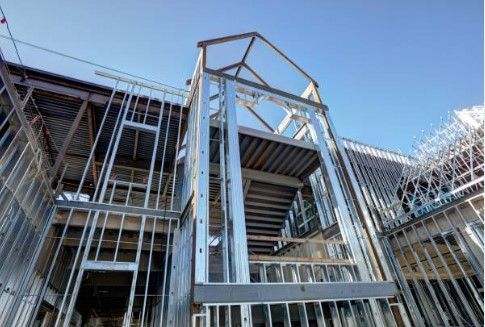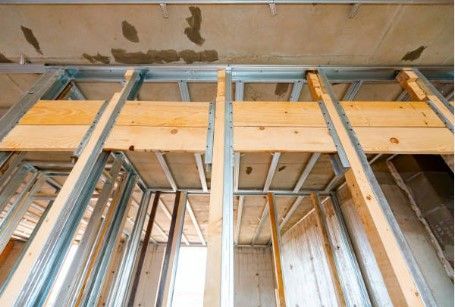778-403-1172
info@vancouversteelframing.com
Buildings With Metal Stud Framing Mean Lower Insurance Rates (Expert Explanation)
Metal stud framing offers a compelling advantage for building construction - to significantly reduce insurance premiums. This benefit stems from the inherent properties of steel compared to traditional structural framing materials.
The Steel Framing Industry Association highlights the rising importance of insurance costs in construction. Representing 5% of construction costs and potentially reaching 10% of long-term operational costs, insurance is a growing concern due to increasing demand and limited underwriting capacity.
This compels developers and owners to explore options that go beyond basic "loss protection" and consider insurance as a tool for maximizing return on investment (ROI).
Why Metal Stud Framing?
Research by the National Institute of Standards and Technology consistently demonstrates the superior fire performance of steel-framed structures.
Even The American Iron and Steel Institute (AISI) reports that buildings constructed with steel studs experience an average insurance premium reduction of 15-30%.
Superior Fire Resistance
| High Melting Point | Steel's melting point exceeds 1400°C, significantly higher than wood's ignition temperature (around 250°C). |
| Slows Fire Spread | During a fire event, steel studs retain structural integrity for an extended period. This delays wall and ceiling system collapse. |
| Reduced Fire Intensity | Minimize the overall fire intensity within the structure. |
| Fire Compartmentalization | Compartmentalize fire within affected areas. Prevent flames from readily spreading throughout the building. |
These fire-resistant properties are directly linked to quantifiable benefits:
- Reduced risk of total loss due to fire translates to lower insurance premiums for building owners.
- Fire damage to structures with structural framing is less extensive than that to structures with wood framing, resulting in quicker and mitigated repair costs.
How Fire Impacts Insurance Rates
Studies by the Insurance Information Institute (III) reveal that fire is a leading cause of property damage, costing insurers billions of dollars annually. Additionally, the National Fire Protection Association (NFPA) indicates that buildings constructed with non-combustible materials experience significantly lower fire losses compared to those with wood stud framing.
- Buildings constructed with non-combustible materials, equipped with robust fire protection systems, and adhering to strict fire codes will be viewed favourably by insurance companies and qualify for lower premiums.
- Buildings with combustible materials, limited fire protection systems, and a history of fire incidents will be considered higher fire risks and face significantly higher insurance premiums.
Insurance Advantage of Framing With Metals
Local Building Codes and Fire Safety Regulations
The Victoria Building Bylaw (VBB) created fire safety standards for all buildings constructed within city limits. The VBB incorporates the National Building Code of Canada (NBC) with some Victoria-specific amendments. These codes establish fire-resistance rating requirements for various building components (axial load-bearing walls, curtain walls, floors, etc.) based on occupancy type and building size.
Any framing system using metals is required to be properly designed and installed to meet the fire-resistance ratings specified in the VBB and NBC. It can significantly contribute to a building's overall fire safety.
Key Technical Aspects
- Steel studs can be incorporated into wall, floor, and ceiling assemblies that achieve specific fire-resistance ratings. These assemblies normally involve multiple layers of materials, including metallic studs, fire-rated gypsum board, and insulation.
- Contribute to passive fire protection by delaying the spread of fire within a building. Their high melting point ensures structural integrity for an extended period.
Cold-formed steel's (CFS) superior fire resistance has garnered recognition from the insurance industry, leading to the development of programs that incentivize its use.
STEEL Advantage Insurance Program
Launched by the Steel Framing Alliance and DiBuduo & DeFendis Insurance Brokers, this program hinges on the non-combustible nature of CFS. This translates to a significantly reduced fire risk compared to traditional framing materials, potentially leading to fewer insurance claims throughout the building's lifespan.
As a result, builders utilizing steel framing can benefit from substantial discounts (up to 43%) on a wide range of insurance products, enhancing CFS's competitiveness in the construction market.
Real-Word Samples of Insurance Savings with Steel Framing
Multi-Story Office Building (National)
- Construction of a six-story office building using cold-formed steel framing instead of cast-in-place concrete.
- Employed fire-rated gypsum board assemblies to achieve the required fire-resistance ratings as per building codes.
- A third-party comparative cost study revealed a net cost difference of $81/m² ($7.50/sq. ft.) in favour of the steel building. This difference included a significant reduction in builder's risk insurance premiums due to the lower fire risk associated with steel framing.
4-story, 400-unit Hotel in Mason, Ohio
| Builder's Risk Insurance | Wood framing would have incurred a premium of $0.70 per $100 of construction value, translating to a total cost of $1.68 million over the 24-month construction period. In contrast, metal framing reduced the premium to $0.15 per $100, resulting in a total cost of $360,000 – a significant savings of $1.32 million. |
| Property Insurance | Buildings with wood framing face annual premiums of $0.12-$0.14 per $100 of final value, whereas metal-framed structures may benefit from premiums as low as $0.07-$0.08 per $100. In this specific example, the annual savings translate to $66,000, accumulating to $660,000 over a 10-year period. |
| General Liability/Wrap Insurance | While concrete framing would incur an annual premium of $2.3 million, cold-formed steel framing reduces the premium to $2 million, translating to annual savings of $300,000. Over a 10-year period, the cumulative savings reach a staggering $3 million. |

Build Smarter and Save on Insurance
Victoria's focus on fire safety aligns perfectly with the inherent fire resistance of metal stud framing. This equates to lower insurance premiums for building owners.
By partnering with qualified professionals and leveraging metal framing's insurance advantages, you can build smarter and achieve significant cost savings on your next Victoria construction project. Contact Victoria Steel Stud Framing today to discuss how this innovation in framing can benefit your project!
Frequently Asked Questions
Beyond fire resistance, are there other reasons metallic studs might impact insurance costs?
Yes. Unlike wood, metal studs are not susceptible to rot or termite infestation. This translates to a lower risk of structural sheet and joist issues that could necessitate repairs and future insurance claims in commercial applications. Some insurers offer lower premiums for buildings with faster construction times, which prefabricated metal stud track systems can facilitate.
Are there different types of metal stud framing that affect fire resistance?
Yes. Cold-formed steel framing is the most common type used for buildings. Within CFS, there are various gauges, loads, and stud profiles. For optimal fire resistance, thicker gauge (thickness) studs and specific profile designs offering additional structural stability are recommended.
Do fire protection systems like sprinklers further reduce insurance costs with metal framing?
Yes. Buildings equipped with robust fire protection systems like sprinklers and fire alarms demonstrate a proactive approach to fire safety. When combined with the inherent fire resistance of metal framing and drywall, this reduces fire risk and potentially leads to even lower insurance premiums from some insurance companies.
